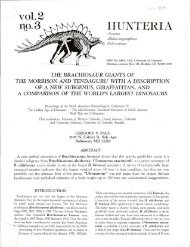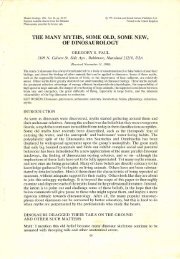THE SEGNOSAURIAN DINOSAURS: RELICS OF ... - Gregory S. Paul
THE SEGNOSAURIAN DINOSAURS: RELICS OF ... - Gregory S. Paul
THE SEGNOSAURIAN DINOSAURS: RELICS OF ... - Gregory S. Paul
You also want an ePaper? Increase the reach of your titles
YUMPU automatically turns print PDFs into web optimized ePapers that Google loves.
dinosaur descendants, it is possible that segnosaurs,<br />
prosauropods, and ornithischians are each derived independently<br />
from early dinosaurs, or that segnosaurs<br />
and ornithischians are derived independently from<br />
prosauropod ancestors. However, these two alternatives<br />
still suffer from unduly high and complex degrees<br />
of convergence without any positive data to justify<br />
them. The best fit explanation of segnosaur origins is<br />
that they are relics of the prosauropod-ornithischian<br />
transition (Fig. 5B').<br />
Morphologically, segnosaurians bridge the gap between<br />
prosauropods and ornithischians. These three<br />
dinosaur groups form a distinctive clade and support<br />
the hypothesis of dinosaur morphology. As little<br />
changed, late survivors of their higher group's early<br />
radiation that have accumulated some specializations<br />
over time and lack a temporally intermediate fossil<br />
record, segnosaurians are to herbivorous dinosaurs what<br />
monotremes are to the mammals. Hopefully, an awareness<br />
ofthis new dinosaur group will spur the discovery<br />
of more of their remains in collections and strata outside<br />
the Late Cretaceous of Mongolia. Segnosaurs are<br />
not the only archosaurian relics in the Mongolian Late<br />
Cretaceous. Gobisuchus (Osm6lska, 1972), a Triassic-<br />
Jurassic-grade crocodiloid, and Opisthocoelicaudia<br />
(Borsuk-Bialynicka, 1977), a somewhat specialized but<br />
otherwise Jurassic grade camarasaurid sauropod, are<br />
also present in these sediments. In the Late Cretaceous<br />
of North America, Parksosaurus is another Triassic-<br />
Jurassic-grade ornithischian that is not much more<br />
derived than the segnosaurs.<br />
CONCLUSION<br />
Because segnosaurians almost certainly are neither<br />
theropods nor their descendants, they are here formally<br />
removed from the Theropoda. Lacking a predentary,<br />
the segnosaurians do not meet a major definition of<br />
the Ornithischia (Seeley, 1887). Nor does the traditional<br />
classification of dinosaurs recognize the possibility<br />
of their monophyly. Until a new, rigorously defined<br />
systematic ordering of the dinosaurs is available,<br />
the segnosaurians should be considered a clade of the<br />
Dinosauria intermediate between pro sauropods and<br />
ornithischians. .<br />
Acknowledgements-I wish to thank R. T. Bakker; H.<br />
Osmolska, T. Maryanska, P. M. Dodsen, G. 01shevsky,<br />
M. K. Brett-Surman, K. Carpenter, M. <strong>Paul</strong>,<br />
and P. Sites for their discussion, criticism and assistance<br />
on this paper.<br />
REFERENCES<br />
Bakker, R. T. 1975. Dinosaur renaissance. Scientific American<br />
232(4):58-78.<br />
--- & Galton, P. M. 1974. Dinosaur monophyly and<br />
a new class of vertebrates. Nature 238:81-85.<br />
Barsbold, R. 1975. New data on the therizinosaurs. Nauka,<br />
Trudy SSPE 3:76-92.<br />
514<br />
--- 1979. Opisthopubic pelvis in the carnivorous dinosaurs.<br />
Nature 279:792-793.<br />
--- 1983. Carnivorous dinosaurs from the Cretaceous<br />
. of Mongolia. The Joint Soviet-Mongolian Palaeontological<br />
Expedition, Transactions 19: 1-116.<br />
--- & Perle, A. 1979. The modification of the saurischian<br />
pelvis and the parallel development of carnivorous<br />
dinosaurs. Joint Soviet-Mongolian Paleontological Expedition,<br />
Transactions 8:39-44.<br />
--- & --- 1980. Segnosauria, a new infraorder of<br />
carnivorous dinosaurs. Acta palaeontologica Polonica<br />
25(2):187-195.<br />
Bonaparte, V. F 1975. Nuevos materiales de Lagosuchus<br />
talampayenis Romer y su significado en el origin de los<br />
Saurischia. Acta geologica Lilloana 13:5-87.<br />
--- 1976. Pisanosaurus mertii Casamiguela and the origin<br />
of the Ornithischia. Journal ofPa1eontology 50:808-<br />
820.<br />
Borsuk-Bialynicka, M. 1977. A new camarasaurid sauropod<br />
Opisthocoelicaudia skarzyukii gen. n., sp. n. from<br />
the Upper Cretaceous of Mongolia. In Results of the<br />
Polish-Mongolian Paleontological Expeditions-Part<br />
VII. Palaeontologia Polonica 37:5-64.<br />
Brett-Surman, M. K. & <strong>Paul</strong>, G. S. In press. Phylogenetics,<br />
biogeography and extinction of the hadrosaurian dinosaurs<br />
and their relatives. Mesozoic Vertebrate Paleontology<br />
I.<br />
Brown, B. & Schlaikjer, E. M. 1943. A study ofthe troodont<br />
dinosaurs with the description of a new genus and four<br />
new species. American Museum of Natural History, Bulletin<br />
82:121-149.<br />
Camp, C. L. 1930. A study of the phytosaurs with description<br />
of new material from western North America. University<br />
of California, Memoirs 10: 1-161.<br />
Charig, A. J. 1976. Dinosaur monophyly and a new class<br />
of vertebrates; a critical review. In Bellairs, A. d'A. &<br />
Cox, C. B. (eds.), Morphology and Biology of Reptiles.<br />
Linnean Society of London, Symposium Series 3:65-<br />
104.<br />
Chatterjee, S. 1982. Phylogeny and classification of thecodontian<br />
reptiles. Nature 295:317-320.<br />
Coombs, W. 1971. The Ankylosauridae. Unpublished Ph.D.<br />
thesis, Columbia University, New York, 487 pp.<br />
Cooper, M. R. 1980. The pro sauropod ankle and dinosaur<br />
. phylogeny. South African Journal of Science 76: 176-<br />
178.<br />
--- 1981. The pro sauropod dinosaur Massospondylus<br />
carinatus Owen from Zimbabwe. Occasional Papers of<br />
the National Museums and Monuments of Rhodesia, B,<br />
Natural Sciences 6(10):689-840.<br />
Cruickshank, A. R. I. 1979. The ankle joint in some early<br />
archosaurs. South African Journal of Science 75:78.<br />
Dong, Z. 1979. Dinosaurs from the Mesozoic redbeds of<br />
Huanan. Field Work Meeting on Cretaceous and Early<br />
Tertiary Redbeds of South China, Special Papers pp.<br />
342-350.<br />
Ewer, R. F 1965. The anatomy of the thecodont reptile<br />
Euparkeria capensis Broom. Royal Society of London,<br />
Philosophical Transactions (B) 248:379-435.<br />
Galton, P. M. 1973a. The cheeks of ornithischian dinosaurs.<br />
Lethaia 6:67-89.<br />
--- 1973b. Redescription of the skull and mandible of<br />
Parksosaurus from the Late Cretaceous with comments<br />
on the family Hypsilophodontidae (Ornithischia). Royal<br />
Ontario Museum, Life Sciences Contributions 89: 1-21.<br />
JVP 4(4), December 1984









